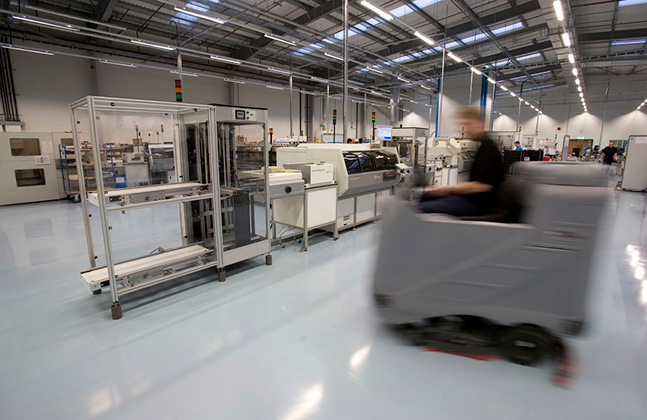The fragile and expensive nature of sensitive electronic components means that they require controlled and stable conditions during manufacture and assembly to ensure low scrap rates, limit failures and to meet the customer’s high expectations.
What’s the Danger?
Static charge build up in the floor can ruin a controlled environment and can lead to electronic components being damaged, degraded or even destroyed. Often this charge is released by the movement of personnel and equipment over the floor surface. Should an uncontrolled discharge of electricity occur it could have a significant impact on productivity, product reliability, rework costs and manufacturing profitability.
In higher risk working environments static charges can even be a serious health and safety concern, this is particularly true in the petroleum, chemical processing, munitions, textiles, aviation, telecommunications, automotive, printing and healthcare sectors.
Industrial spaces have to factor in the risk of explosive vapour or air mixtures forming in the production and adjacent areas due to the handling of flammable liquids, powders and gases, as an electrostatic discharge sparking could ignite these.
How Does Antistatic Flooring Help?
Antistatic flooring solutions can be utilised to reduce these unwanted risks by dissipating the electrostatic charge before it has the chance to build up to dangerous levels.
Resin Electrostatic Discharge (ESD) floor systems can be specified in both conductive and dissipative designs, depending on the requirements of the facility. To give you an example of which type is usually installed in different industries, conductive flooring (25,000 to 100,000 ohms resistance) is commonly used in facilities such as ammunition manufacturing, while electronics manufacturing will most often specify flooring in the dissipative range 106-109 ohms.
Flowcrete has developed a variety of antistatic flooring systems for static sensitive environments that allows architects and consultants to select a solution that meets the specific needs of the work area in question. This comprehensive product range means that whether the facility includes production and assembly rooms, storage areas, office space, R&D facilities or clean rooms, there is a floor finish available that will meet its needs.
Unlike alternative flooring materials, these Flowcrete surfaces don’t require periodic treatment to maintain an antistatic control capability that complies with the latest ANSI/ESD standards. ESD performance tests conducted at regular intervals over different points of the floor will prove the long-lasting effectiveness of the finish.
Flooring Choice
Alongside these antistatic properties, Flowcrete’s floors have wider application benefits that will help to optimise the working environment. For even more choice, ESD properties can be combined into Flowcrete flooring ranges aimed at other markets. The range of colours and decorative effects on offer means that the developer can choose a finish in line with their aesthetic requirements, an advantage that can be utilised to create a pleasant working environment, tie a space to a corporate identity and make it visually appealing to visitors.
This blog post was created by Flowcrete India, to find out more about their antistatic floors please click here.





